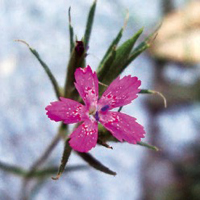[Vascular spontaneous flora of the town of Modena: analysis of the historic centre]

Accepted: 19 June 2020
All claims expressed in this article are solely those of the authors and do not necessarily represent those of their affiliated organizations, or those of the publisher, the editors and the reviewers. Any product that may be evaluated in this article or claim that may be made by its manufacturer is not guaranteed or endorsed by the publisher.
Authors
[The results of the first systematic study concerning the urban flora of Modena are here presented. Data collection was carried out in 2014-2018, by inspecting every road and square of the historic centre, intended as the area encompassed within the wide avenues that retrace the layout of the 16th century ramparts. 344 plant species were found, of which 1 is new for the flora of Italy, 10 are new for Emilia-Romagna and 19 are new for the province of Modena. Among these 30 new species, alien species make up 63%. There are 17 species no longer found during this study, which were observed at least 20 years ago or were testified only by late 19th century herbarium samples. The life form spectrum is dominated by the therophytes (44%), followed by hemicryptophytes (28%) and phanerophytes (15%). Eurasian (28%), Mediterranean (24%) and cosmopolite species (24%) dominate the chorological spectrum. Neophytes are 18% of the total number of species, quite a low percentage if compared with what was observed in other towns of the Po Plain and Central Europe. This fact is probably due to the small area of the historic city centre, whose compact urbanistic structure seems to resist against the diffusion of alien plants. The invasive species are 11% of the total. The presence of 15 hygrophilous species is interesting, since they indicate irrigation or hyper-irrigation of lawns and flowerbeds. We found 4 protected species at the regional level, of which 2 are escaped from cultivation. Concerning the affinity of the species to urban ecology, the floristic list is dominated by the urban-neutral (45%) and urbanophilous species (42%). This fact can indicate a good variety in terms of growth environments, with most of them probably in a quite advanced phase of ecological evolution for an urban centre, and also a fairly good environmental quality, likely due – at least partially – to the abundance of green areas. The species richness in every road or square is strongly correlated to the environmental heterogeneity (ρ = 0,794) and moderately correlated to the nearby presence of green areas (ρ = 0,544) and to the road length or square surface (ρ = 0,665 and 0,673, respectively). Furthermore, a weak correlation (ρ = 0,212) exists between the presence of horticultural or food species and the presence of restaurants in the same road or square. Therefore, the town is confirmed to be a very dynamic ecosystem with great biological richness, useful to understand the ecological strategies developed by plants to adapt to sometimes very unfavourable conditions. In addition, during the process of colonisation of a region, urban areas often act as a «hub» for the spreading of species along the road and railway network. Understanding and respecting the ecological roles of native species is thus fundamental for modern urban planning, aimed at improving the quality of life as a whole.]
[Article in Italian]
How to Cite
PAGEPress has chosen to apply the Creative Commons Attribution NonCommercial 4.0 International License (CC BY-NC 4.0) to all manuscripts to be published.
Similar Articles
- Paul Smith, Sergio D. Ríos, Status and distribution of Paraguayan Procyonidae and Mephitidae (Mammalia: Carnivora) , Natural History Sciences: Vol. 11 No. 1 (2024)
- Luigi Cagnolaro, Michela Podestà, Marco Affronte, Paolo Agnelli, Fabrizio Cancelli, Ernesto Capanna, Rossella Carlini, Giorgio Cataldini, Bruno Cozzi, Gianni Insacco, Nicola Maio, Letizia Marsili, Paola Nicolosi, Vincenzo Olivieri, Roberto Poggi, Tommaso Renieri, Maurizio Wurtz, Collections of extant cetaceans in Italian museums and other scientific institutions. A comparative review , Natural History Sciences: Vol. 153 No. 2 (2012)
- Enrico Lunghi, Alessandro Monti, Arturo Binda, Ionne Piazzi, Maurizio Salvadori, Roberto Cogoni, Luigi Andrea Riefolo, Carlo Biancardi, Sergio Mezzadri, Domenico Avitabile, Gentile Francesco Ficetola, Manuela Mulargia, Salvatore Manca, Pauline Blaimont, Anna Rita Di Cerbo, Raoul Manenti, Cases of albinism and leucism in amphibians in Italy: new reports , Natural History Sciences: Vol. 4 No. 1 (2017)
- Gabriel Lio, Federico Agnolin, Andrea Cau, Simone Maganuco, Crocodyliform affinities for Kemkemia auditorei Cau & Maganuco, 2009 from the Late Cretaceous of Morocco , Natural History Sciences: Vol. 153 No. 1 (2012)
- Davide Federico Bertè, Remarks on the skull morphology of Canis lupaster Hemprich and Herenberg, 1832 from the collection of the Natural History Museum “G. Doria” of Genoa, Italy , Natural History Sciences: Vol. 4 No. 1 (2017)
- Giovanni Pasini, Antonio De Angeli, Alessandro Garassino, Calappa praelata Lőrenthey in Lőrenthey & Beurlen, 1929 (Decapoda, Brachyura, Calappidae) from the Middle Miocene of Tresnuraghes (Oristano, Sardegna, Italy) , Natural History Sciences: Vol. 153 No. 1 (2012)
- Endang Saptiningsih, Sri Darmanti, Nintya Setiari, Tolerance of Capsicum frutescens L. (Solanales: Solanaceae) to the duration of waterlogging and impact on the post-waterlogging and recovery periods , Natural History Sciences: Vol. 10 No. 2 (2023)
- Laura Farina, New data on Longitarsus rubellus species group with description of a new species from Western Balkans (Coleoptera: Chrysomelidae: Alticini) , Natural History Sciences: Vol. 10 No. s1 (2023)
- Andrea Lombardo, Giuliana Marletta, No longer so common: findings of Calliopaea bellula d’Orbigny 1837 (Gastropoda: Sacoglossa) and Tayuva lilacina (A. Gould 1852) (Gastropoda: Nudibranchia) along the central-eastern coast of Sicily (Ionian Sea) , Natural History Sciences: Vol. 10 No. 1 (2023)
- Roberto Battiston, Carlo Galliani, On the life-cycle of ameles spallanzania (Rossi, 1792) (Insecta, Mantodea) , Natural History Sciences: Vol. 152 No. 1 (2011)
<< < 1 2 3 4 5 6 7 8 9 10 > >>
You may also start an advanced similarity search for this article.


 https://doi.org/10.4081/nhs.2020.443
https://doi.org/10.4081/nhs.2020.443






